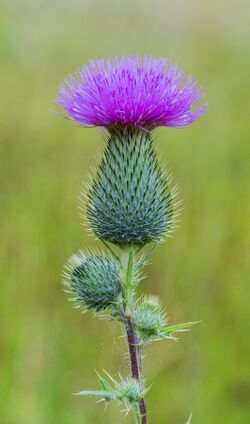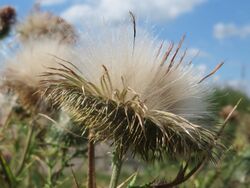Biology:Cirsium vulgare
| Cirsium vulgare | |
|---|---|

| |
| Plant in flower, Joure, Netherlands | |

| |
| Seedhead | |
| Scientific classification | |
| Kingdom: | Plantae |
| Clade: | Tracheophytes |
| Clade: | Angiosperms |
| Clade: | Eudicots |
| Clade: | Asterids |
| Order: | Asterales |
| Family: | Asteraceae |
| Genus: | Cirsium |
| Species: | C. vulgare
|
| Binomial name | |
| Cirsium vulgare (Savi) Ten.
| |
| Synonyms[1] | |
|
Synonymy
| |
Cirsium vulgare, the spear thistle, bull thistle, or common thistle, is a species of the Asteraceae genus Cirsium, native throughout most of Europe (north to 66°N, locally 68°N), Western Asia (east to the Yenisei Valley), and northwestern Africa (Atlas Mountains).[2][3][4][5] It is also naturalised in North America, Africa, and Australia and is an invasive weed in some areas.[6][7][8] It is the national flower of Scotland.
The plant provides a great deal of nectar for pollinators. It was rated in the top 10 for most nectar production (nectar per unit cover per year) in a UK plants survey conducted by the AgriLand project which is supported by the UK Insect Pollinators Initiative.[9] Marsh thistle, Cirsium palustre, was ranked in first place while this thistle was ranked in sixth place. It also was a top producer of nectar sugar in another study in Britain, ranked third with a production per floral unit of (2300 ± 400 μg).[10]
Description
It is a tall biennial or short-lived monocarpic thistle, forming a rosette of leaves and a taproot up to 70 cm long in the first year, and a flowering stem 1–1.5 m tall in the second (rarely third or fourth) year. It can grow up to 1.8 metres (5 ft 11 in) tall.[11] It sometimes will function as an annual, flowering in the first year. The stem is winged, with numerous longitudinal spine-tipped wings along its full length. The leaves are stoutly spined, grey-green, deeply lobed; the basal leaves grow up to 30 centimetres (12 in) long,[11] with smaller leaves on the upper part of the flower stem; the leaf lobes are spear-shaped (from which the English name derives). The inflorescence is 2.5–5 cm diameter, pink-purple, with all the florets of similar form (no division into disc and ray florets). The seeds are 5 mm long, with a downy pappus, which assists in wind dispersal. As in other species of Cirsium (but unlike species in the related genus Carduus), the pappus hairs are feathery with fine side hairs.[12][13]
Ecology
Spear thistle is often a ruderal species, colonising bare disturbed ground, but also persists well on heavily grazed land as it is unpalatable to most grazing animals.[13] Nitrogen-rich soils help increase its proliferation.[14] The flowers are a rich nectar source used by numerous pollinating insects, including honey bees, wool-carder bees, and many butterflies.[15] The seeds are eaten by goldfinches, linnets and greenfinches.[16] The seeds are dispersed by wind, mud, water, and possibly also by ants; they do not show significant long-term dormancy, most germinating soon after dispersal and only a few lasting up to four years in the soil seed bank.[17] Seed is also often spread by human activity such as hay bales.[13]
Weed status
Spear thistle is designated an "injurious weed" under the UK Weeds Act 1959,[18] and a noxious weed in Australia[17][19][20] and in nine US states.[21] Spread is only by seed, not by root fragments as in the related creeping thistle C. arvense. It is best cleared from land by hoeing and deep cutting of the taproot before seeds mature; regular cultivation also prevents its establishment.[13]
Despite this label, the plant has beneficial qualities beyond its very high nectar production. It produces seeds eaten by the American goldfinch, down from seed pods that is used by those birds for nesting material, and serves as a host plant for the painted lady butterfly. The monarch butterfly and other larger-sized butterflies can feed easily from the flowers due to their large size. Some farmers, due to its usefulness as part of the natural food chain, may find it useful to allow it to grow in beetle banks. The supports for pollinators and pest-eating birds could outweigh its drawbacks. In areas where it does not form monocultures it may also be welcome as a part of a meadow landscape.[citation needed]
Other names
Common names include bull thistle,[13][22] Scots, Scottish, or Scotch thistle, and common thistle.[22]
Uses
The stems can be peeled (removing their spiny surfaces) and then steamed or boiled.[11] The tap roots can be eaten raw or cooked, but are only palatable on young thistles that have not yet flowered.[23] The dried florets steeped in water are used in rural Italy for curdling goats' milk in preparation for making cheese.[citation needed]
In culture
The plant features in some Scottish ceremonies such as the "Riding of the Marches", held annually in Langholm in July. The 1992 specimen measured six feet in length[24]
Spear thistle is also the emblem of Newton Regis in England.[24]
References
- ↑ The Plant List, Cirsium vulgare (Savi) Ten.
- ↑ Flora Europaea: Cirsium vulgare
- ↑ Den Virtuella Floran: Cirsium vulgare (in Swedish, with maps)
- ↑ Altervista Flora Italiana, Cardo asinino, Cirsium vulgare (Savi) Ten.
- ↑ Flora of China, 翼蓟 yi ji, Cirsium vulgare (Savi) Tenore
- ↑ Flora of North America, Bull or common or spear thistle, gros chardon, chardon vulgaire ou lancéolé, piqueux, Cirsium vulgare (Savi) Tenore
- ↑ Atlas of Living Australia, Cirsium vulgare (Savi) Ten., Black Thistle
- ↑ Conservatoire et Jardin botaniques & South African National Biodiversity Institute, African Plant Database, Cirsium vulgare (Savi) Ten.
- ↑ "Which flowers are the best source of nectar?". Conservation Grade. 15 October 2014. http://www.conservationgrade.org/2014/10/which_flowers_best_source_nectar/.
- ↑ Hicks, DM; Ouvrard, P; Baldock, KCR (2016). "Food for Pollinators: Quantifying the Nectar and Pollen Resources of Urban Flower Meadows". PLOS ONE 11 (6): e0158117. doi:10.1371/journal.pone.0158117. PMID 27341588. Bibcode: 2016PLoSO..1158117H.
- ↑ Jump up to: 11.0 11.1 11.2 Elias, Thomas S.; Dykeman, Peter A. (2009). Edible Wild Plants: A North American Field Guide to Over 200 Natural Foods. New York: Sterling. pp. 115. ISBN 978-1-4027-6715-9. OCLC 244766414. https://www.worldcat.org/oclc/244766414.
- ↑ Blamey, M. & Grey-Wilson, C. (1989). Flora of Britain and Northern Europe. ISBN:0-340-40170-2
- ↑ Jump up to: 13.0 13.1 13.2 13.3 13.4 Bond, W., Davies, G., & Turner, R. J. (2007). The biology and non-chemical control Spear Thistle (Cirsium vulgare). 6pp. HDRA the organic organisation. 2006 Version
- ↑ "Bull thistle". Colorado Weed Management Association. http://www.cwma.org/BullThistle.html.
- ↑ "Cirsium vulgare (Savi) Ten.". Department of Environment and Conservation. Government of Western Australia. http://florabase.calm.wa.gov.au/browse/profile/7937.
- ↑ "Spear thistle – Cirsium vulgare". Natural England. The Plant Press. http://www.plantpress.com/wildlife/o799-spearthistle.php.
- ↑ Jump up to: 17.0 17.1 "Spear thistle". Weed Australia. Australian Weeds Committee National Initiative. http://www.weeds.org.au/cgi-bin/weedident.cgi?tpl=plant.tpl&state=&s=&ibra=all&card=H71.
- ↑ Defra, UK – Farming – Wildlife and plants Ragwort and injurious weeds
- ↑ "Spear Thistle". Department of Primary Industries. Victorian Government. http://www.dpi.vic.gov.au/dpi/vro/vrosite.nsf/pages/sip_spear_thistle.
- ↑ "Declared Plant Policy". Primary Industries and Resources SA. Government of South Australia. http://www.pir.sa.gov.au/_media/pdf/pirsa_internet/biosecurity/nrm_biosecurity/pest_weed_policies/declared_plants_2/spear_thistle_policy.pdf.
- ↑ "USDA PLANTS Profile for Cirsium vulgare". USDA Plant Database. USDA. http://plants.usda.gov/java/profile?symbol=CIVU.
- ↑ Jump up to: 22.0 22.1 {{citation | mode = cs1 | title = Cirsium vulgare | work = Germplasm Resources Information Network (GRIN) | url = | publisher = [[Organization:Agricultural Research ServAgricultural Research Service (ARS), United States Department of Agriculture (USDA) | access-date = 15 December 2017 }}
- ↑ "Cirsium". Survival and Self Sufficiency. http://www.survival.org.au/bf_cirsium.php.
- ↑ Jump up to: 24.0 24.1 Mabey R. 1996. Flora Britannica. Sinclair-Stevenson.ISBN:1-85619-377-2
External links
- "Cirsium vulgare". http://www.pfaf.org/user/Plant.aspx?LatinName=Cirsium+vulgare.
- Calflora: Information on California plants for education, research and conservation, with data contributed by public and private institutions and individuals, including the Consortium of California Herbaria, Berkeley, California: The Calflora Database, https://www.calflora.org/cgi-bin/species_query.cgi?where-taxon=Taxon name (parameter 1) is required.
Wikidata ☰ Q21177 entry
 |

